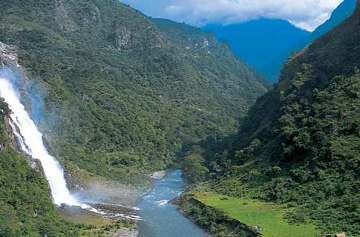Arunachal Pradesh
China’s proposal to build dams on the Brahmaputra’s Tibetan stretch is threatening to kill the gushing tributaries of one of the biggest rivers of South Asia. The course of the Brahmaputra after it enters India sees the river drastically lose height, creating several waterfalls and rapids, making the white waters ideal for rafting. Although China has said that it would not build reservoirs with these dams and, therefore, not affect the water levels downstream, the construction of a dam on the Subansiri River tributary has already put an end to rafting on that stretch. China’s effort to generate more hydroelectricity is sure taking the charge away from India’s adventure tourism.
Mount Kilimanjaro, Tanzania
This is not just for the mountaineering enthusiast. The sheer marvel of the world’s tallest free-standing mountain rising amid the arid vastness of north-east Tanzania has fascinated and captured the imagination of innumerable people through the ages. The Africans worship their ‘White Mountain’, which is a dormant volcano. But the snows of Kilimanjaro — as Ernest Hemingway famously put it — are fast receding, thanks to global warming. Researchers claim that about 85 percent of the snow that covered the mountain’s peak had disappeared by 2007. The glaciers on the mountain are shrinking and thinning at the same time. Loss of vegetation around the mountain too is believed to have had an impact.
Turtuk, Ladakh
This border village in the Nubra Valley of Ladakh once fell within Pakistan Occupied Kashmir. Although India reclaimed it after the 1971 war, the government imposed the Protected Area Permit Regime in the area, making it off-limits for foreigners. This, however, ensured that the region’s stark beauty remain untouched. Towards the end of 2009 the government lifted its restrictions. Foreign tourists have, since then, been queuing up for Bactrian camel rides and hot water springs. There goes the neighborhood.
The Caribbean
The coral reefs of the Caribbean are some of the world’s best for scuba diving, with consistent conditions throughout the year, and dive spots suitable for everyone from novices to PADI-certified instructors. Spots such as Bonaire and the Dutch Caribbean offer shallow diving among coral reefs while Provo, Turks and Caicos are must-visits for snorkelling. But pollution — increased levels of carbon dioxide in the sea water — and global warming are taking a toll on them: While acidic waters affects the corals’ ability to secrete new skeletons, warmer waters disrupt their growth. Frequent hurricanes don’t help either. Plan that Caribbean cruise soon.
The Western Ghats
The Marathas built fortresses that were protected by the difficult terrain and isolation. But now, with developments like the Mumbai-Pune Expressway scything through the hills and making transport a breeze, developers are conquering the Ghats. Planned cities that took advantage of changes in the land zoning regulations in the area, which converted hill and agricultural land to residential and commercial ones, are taking shape. Leading the pack: Aamby Valley (10,000 acres) and Lavasa (25,000 acres of land and 60 km of lakefront). And the Ghats, nominated for a place on the Unesco World Heritage List, home to more than 300 threatened species, and one of the world’s top 10 biodiversity hotspots, look like becoming the middle of a vast Mumbai-Pune megapolis. Get that monsoon trekking done soon.

dear sir,
thank you for introducing my village “TURTUK”
I on behalf of the first accommodation RESORT ” TURTUK HOLIDAY CAMP”
http://wikimapia.org/16937246/Turtuk-Holiday-Camp and the peoples of this area Would like to heartiest thanks for this great job.
thanx and regards.
Attaullah
turtuk holiday camp
cell: 919906993123
email: turtuk.holiday@gmail.com